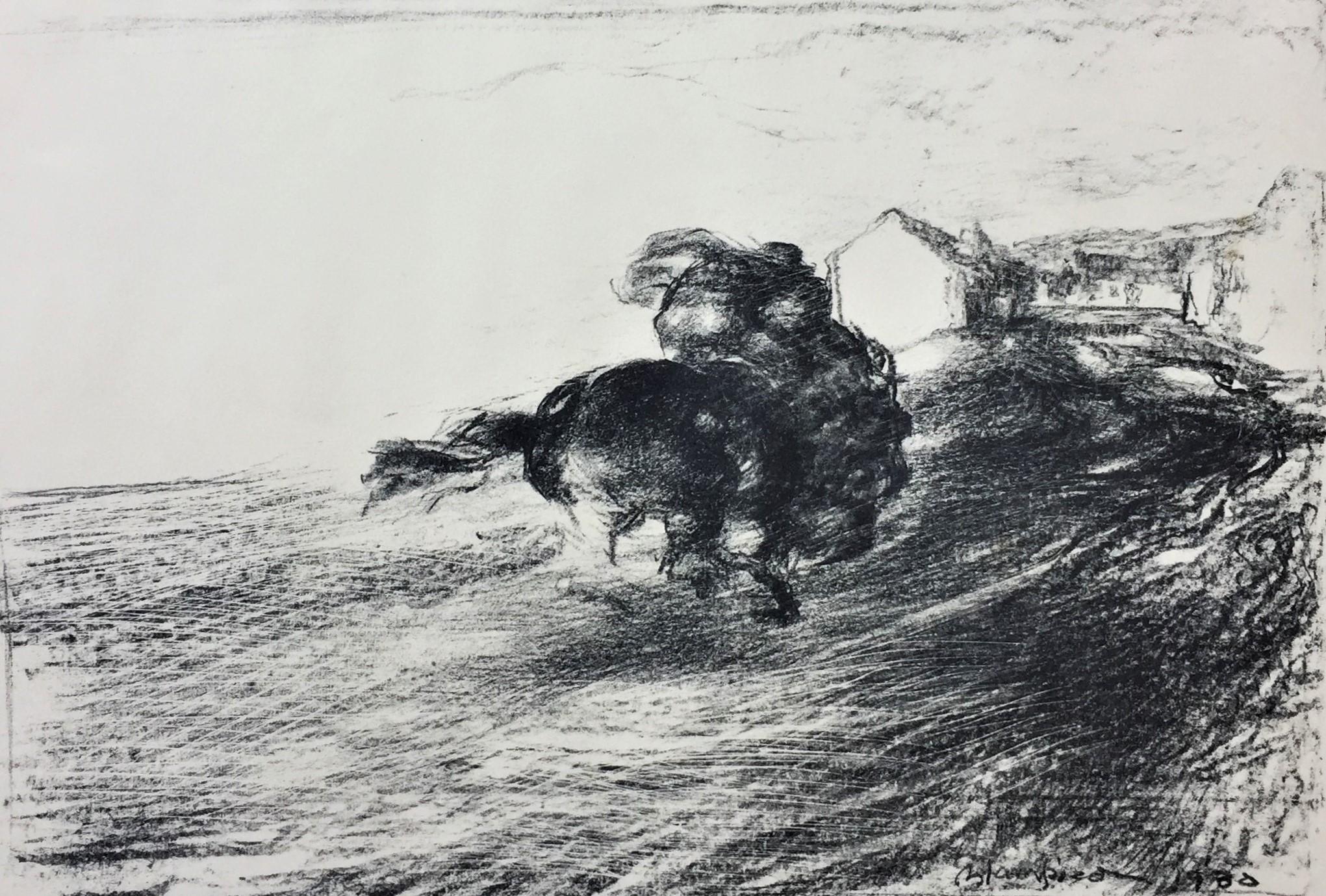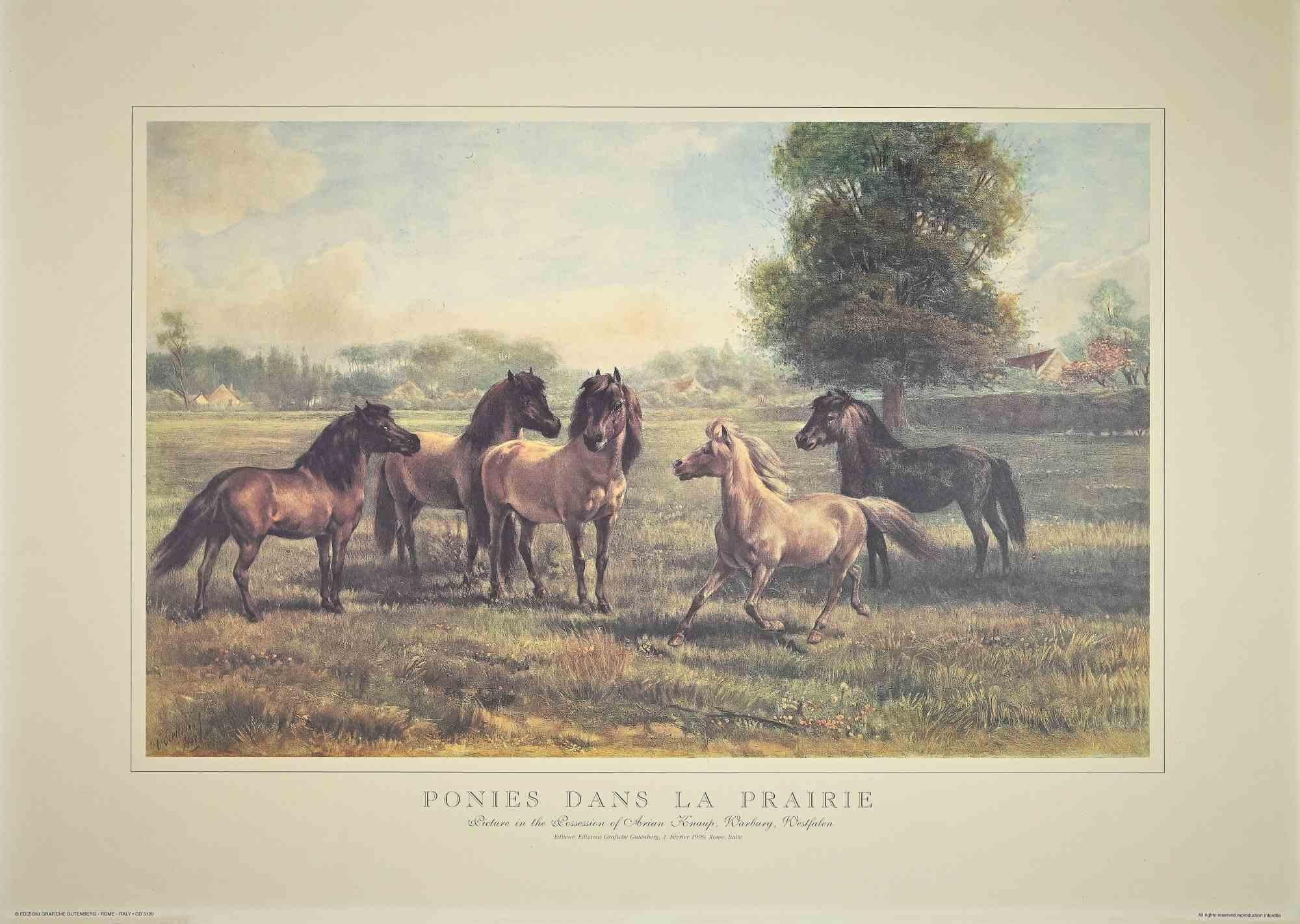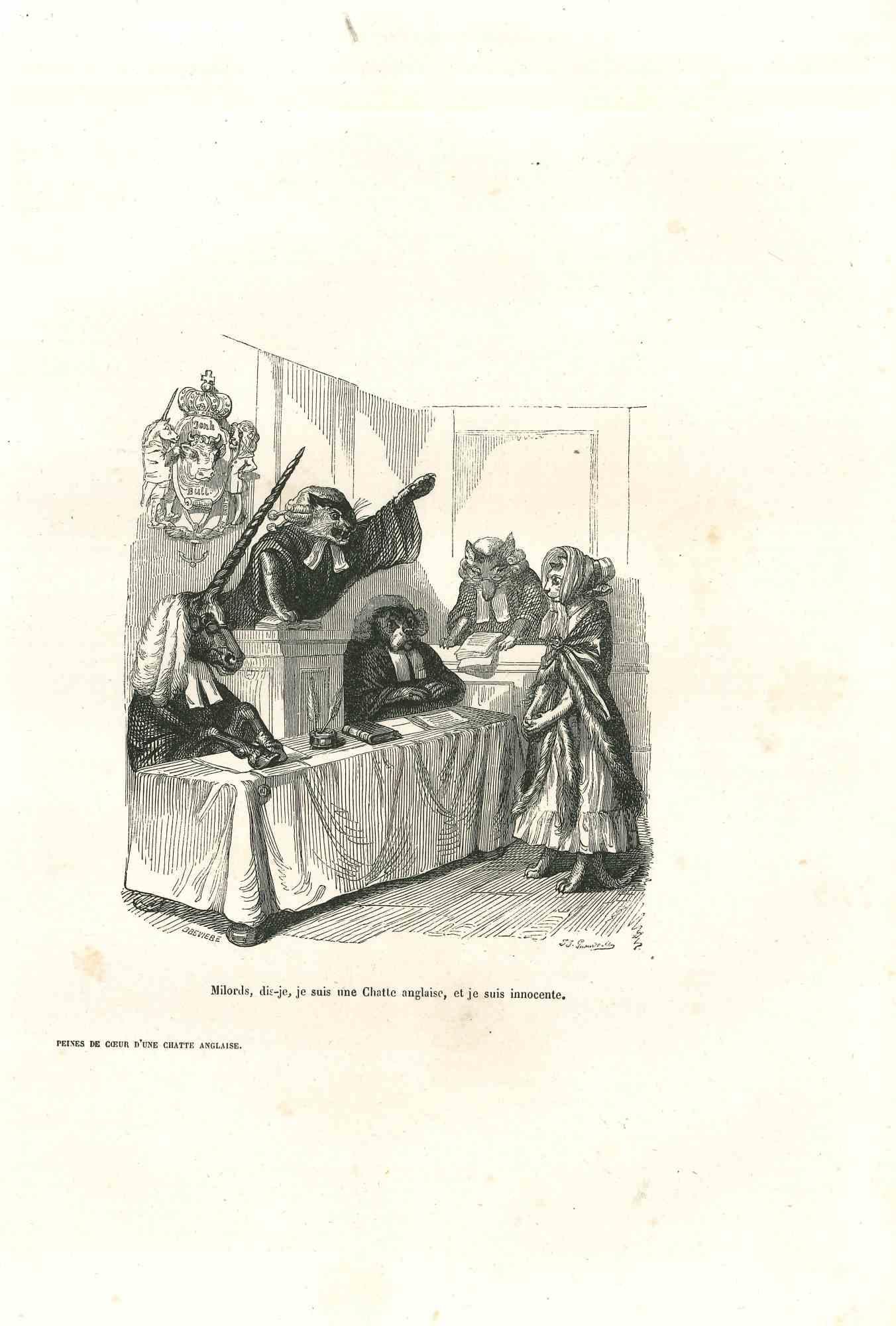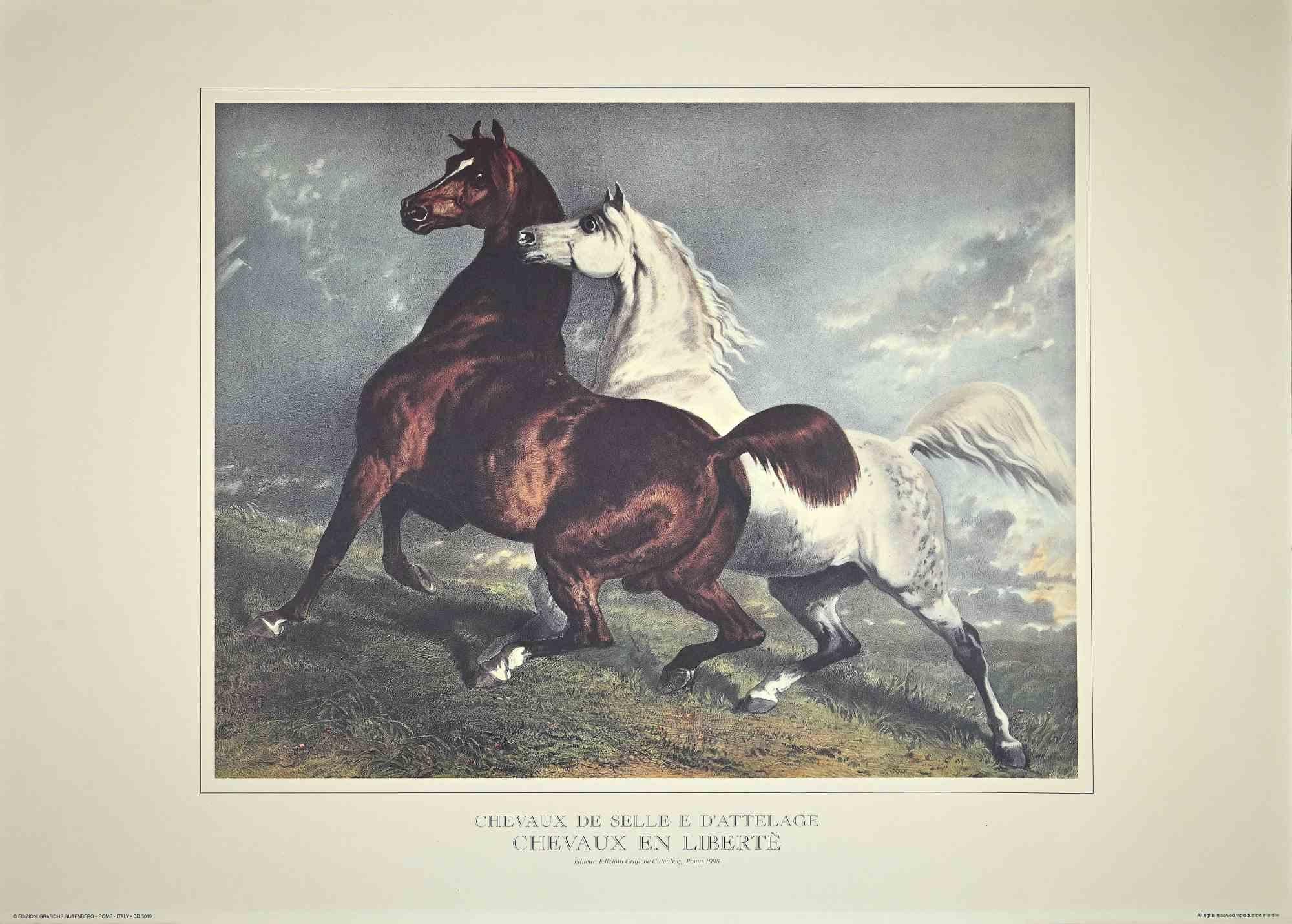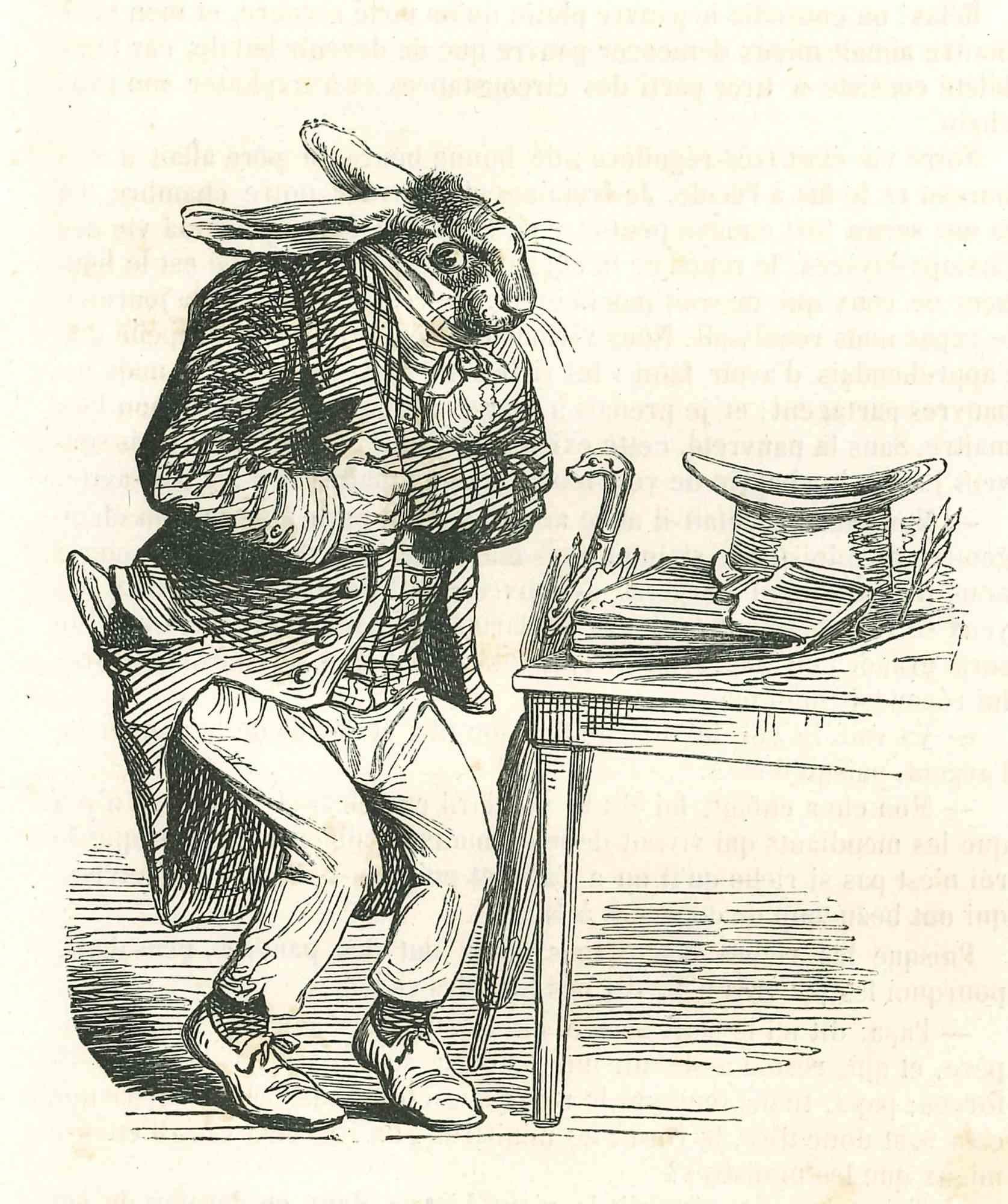Items Similar to Vous ne le croirez pas ma chère? - Lithograph by J.J. Grandville - 19th Century
Want more images or videos?
Request additional images or videos from the seller
1 of 5
J.J. GrandvilleVous ne le croirez pas ma chère? - Lithograph by J.J. Grandville - 19th Century19th Century
19th Century
About the Item
Vous ne le croirez pas ma chère? is an original lithograph on ivory-colored paper realized by J.J. Grandville in the 19th Century.
Good Conditions.
Jean Ignace Isidore Gérard (13 September 1803, Nancy, Meurthe-et-Moselle – 17 March 1847, Vanves), generally known by the pseudonym of Jean-Jacques or J. J. Grandville, was a French caricaturist. Grandville received his first instruction in drawing from his father, a painter of miniatures. At the age of twenty-one he moved to Paris, and soon afterwards published a collection of lithographs entitled Les Tribulations de la petite proprieté. He followed this with Les Plaisirs de tout âge and La Sibylle des salons (1827); but the work which first established his fame was Les Métamorphoses du jour (1828–29), a series of seventy scenes in which individuals with the bodies of men and faces of animals are made to play a human comedy. These drawings are remarkable for the extraordinary skill with which human characteristics are represented in animal facial features.
After the reinstitution of prior censorship of caricature in 1835, Grandville turned almost exclusively to book illustration, supplying illustrations for various standard works, such as the songs of Béranger, the fables of La Fontaine, Don Quixote, Gulliver's Travels, Robinson Crusoe. He also continued to issue various lithographic collections, among which may be mentioned La Vie privée et publique des animaux, Les Cent Proverbes, Un Autre Monde and Les Fleurs animées.
Though the designs of Grandville are occasionally unnatural and absurd, they usually display keen analysis of character and marvellous inventive ingenuity, and his humour is always tempered and refined by delicacy of sentiment and a vein of sober thoughtfulness. He died on 17 March 1847 and is buried in the Cimetière Nord of Saint-Mandé just outside Paris. A short notice of Grandville appears in Théophile Gautier's Portraits contemporains.
- Creator:J.J. Grandville
- Creation Year:19th Century
- Dimensions:Height: 11.03 in (28 cm)Width: 14.18 in (36 cm)Depth: 0.04 in (1 mm)
- Medium:
- Movement & Style:
- Period:
- Framing:Framing Options Available
- Condition:Insurance may be requested by customers as additional service, contact us for more information.
- Gallery Location:Roma, IT
- Reference Number:
About the Seller
4.9
Platinum Seller
These expertly vetted sellers are 1stDibs' most experienced sellers and are rated highest by our customers.
1stDibs seller since 2017
6,839 sales on 1stDibs
Typical response time: 3 hours
- ShippingRetrieving quote...Ships From: Monaco, Monaco
- Return PolicyA return for this item may be initiated within 14 days of delivery.
More From This SellerView All
- Poinies dans la Prairie - Lithograph - 20th CenturyLocated in Roma, ITPoinies dans la Prairie is an original Lithograph, realized by an anonymous artist in the 20th Century. The status of preservation Good. The artwork is de...Category
Late 20th Century Modern Figurative Prints
MaterialsLithograph
- Innocent Mrs. Cat In The Court - Lithograph by J.J Grandville - 1852By Jean Jeacques GrandvilleLocated in Roma, ITInnocent Mrs. Cat In The Court is an original lithograph on ivory-colored paper realized by J.J. Grandville from Scènes de la vie privée et publique des animaux, 1852. Published by M...Category
1850s Modern Animal Prints
MaterialsLithograph, Paper
- Chevaux en Liberté - l Lithograph - 20th CenturyLocated in Roma, ITChevaux en Liberté is an original Lithograph, realized by an anonymous artist in the late 20th Century. The status of preservation Good. The artwork is de...Category
Late 20th Century Modern Figurative Prints
MaterialsLithograph
- The Lawyer Bunny In A Hurry - Lithograph by J.J Grandville - 1852By Jean Jeacques GrandvilleLocated in Roma, ITThe Lawyer Bunny In A Hurry is an original lithographs on ivory-colored paper realized by J.J. Grandville from Scènes de la vie privée et publique des anima...Category
1850s Modern Animal Prints
MaterialsLithograph, Paper
- Elephant - Original Lithograph by Emmanuel Gondouin - 1930sLocated in Roma, ITElephant is an original lithograph realized in the early 1930s by Emmanuel Gondouin, (Versailles, 1883 - Parigi, 1934) The artwork is depicted through strong strokes and is part of...Category
1930s Modern Animal Prints
MaterialsLithograph
- The MonarchsBy Giorgio De ChiricoLocated in Roma, ITOriginal title: “I Monarchi” Hand signed and Signed on plate.Edition of 15 prints in Roman Numerals. This is one lithograph from the series “Cavalli” published in Rome by Carlo Best...Category
1940s Modern Figurative Prints
MaterialsLithograph
You May Also Like
- Fetching the Doctor (In Haste for the Doctor)By Edmund BlampiedLocated in Storrs, CTFetching the Doctor (In Haste for the Doctor) 1930. Lithograph. Appleby Lithographs 24. 11 x 16 (sheet 13 3/8 x 18 1/2). Edition 50. Illustration used as a ...Category
Early 20th Century Modern Animal Prints
MaterialsLithograph
- 1959 Israeli Avraham Ofek Leviathan Modernist Lithograph, Bull, Bezalel SchoolBy Avraham OfekLocated in Surfside, FLBright, vibrant purple, red and black bull or ox. 1959 Lithograph "Bull". This was from a portfolio which included works by Yosl Bergner, Menashe Kadishman, Yosef Zaritsky, Aharon Kahana, Jacob Wexler, Moshe Tamir and Michael Gross. Avraham Ofek (August 14, 1935 – January 13, 1990 was an Israeli sculptor, muralist, painter and printmaker. Avraham Ofek was born in Burgas, Bulgaria. He immigrated to Israel in 1949, and he lived in Ein Hamifratz, a kibbutz near Haifa. He studied at the Academy of Fine Arts in Florence, as well as in Spain and in London, and later taught art in Jerusalem before being appointed head of the Art Department at the University of Haifa. In 1975, he established the Leviathan Group school together with Michail Grobman and Shmuel Ackerman (prominent Post Soviet avant garde Russian artists), seeking to combine symbolism, metaphysics and Judaism in an all-inclusive “national style.” He represented Israel at the Venice Biennale in 1972. Avraham Ofek's early paintings of landscape were at both lyrical and rugged; later in his career the landscape was undefined and receded into the background. Near the end of his life, the landscape of Jerusalem became an important motif, reflecting loss and despair. Many of Ofek's landscapes convey a sense of alienation and solitude, as well as nostalgia for the city of his birth, Sofia. His mural paintings and sculpture can be seen across Israel, notably at Kfar Uria and the Central Post Office Building (Jerusalem). His sculpture "The Binding of Isaac...Category
1950s Modern Animal Prints
MaterialsLithograph
- Georges Braque - Original LithographBy Georges BraqueLocated in Collonge Bellerive, Geneve, CHGeorges Braque - Original Lithograph 1963 Dimensions: 32 x 24 cm Andre Sauret, Monte Carlo The father of Cubism Three Cubist that distinguishes art historian periods were initiated and developed by Georges Braque: The Cubist Cézanne (1907-1909), Executive (1909-1912) and synthetic (1912-1922). Post-Impressionist and fawn, Braque no longer adheres to the contingency of a decorative way or the other. Cézanne’s paintings exhibited at the Grand Palais during the retrospective of 1907 are a revelation: Cézanne sought and invented a pictorial language. In his footsteps, Braque went to the South with the reasons of the Master. He returned with Estaque landscapes and surprising Ciotat it keeps Cezanne geometric model and retains the “passages” continuity from one surface to another to create the sensation of “turning around” of the object represented. But he wants to go after the consequences of the vision of Cezanne. In his paintings Houses in L’Estaque (1908) it simplifies the volumes of houses, neglects detail by removing doors and windows: the plastic rhythm that builds the table. Large Nude , a masterpiece of the period, can be considered the first work of Cézanne cubism . Systematizing and deepening Braque discoveries open the door analytical cubism. In 1909, his painting became more cerebral than sensual. The pattern is recreated in the two-dimensionality of the canvas, leaving aside any illusionistic perspective. In Still Life with Violin, objects are analyzed facets according to their characteristic elements, each facet referring to a particular view of the object. There are so many facets of points selected view: Table reflects the knowledge of the object and the ubiquity of the eye. Moreover, Braque is looking for the essence of the objects in the world rather than their contingency, which explains the absence of light source and use of muted colors (gray, ocher), contingent aspects of the object . But formal logic has stepped facets, erased any anecdote to the object and ultimately led to his painting a hermetic more marked on the edge of abstraction (see the series of Castle Roche-Guyon ). Braque, anxious to keep the concrete and refusing at all costs that the logic of Cubism takes the paintings to abstract, reintroduced signs of reality in his paintings in 1912 marks the beginning of Synthetic Cubism. Historians speak of “signs of real” rather than reality because what interests Braque, this is not to put reality into a table, but to create a painting which, by its language, refers to the real. To do this, he invented two major techniques XX th century inclusions and contributions. The inclusions consist of painting objects that have no real depth, materials (wallpaper in Nature morte aux playing cards faux wood is a pictorial inclusion) or letters (calligraphic inclusion in Portuguese ), made first brush and a few months later stencil. Contributions are defined in contrast with the collage on canvas of foreign materials: glued or sand paper, sawdust, etc.. Regarding the collages, Braque used for the first time in September 1912 a piece of adhesive paper imitating faux wood Compote and Glass , then the packet envelope of tobacco Bock in 1912-1913, or an advertisement in Damier , 1913). Inputs and inclusions refer to an external object in the table, without “emulate” this object. Away from their appearances, objects are represented in closest essence of the objects in the real world sense. This is also the time of Synthetic Cubism that Braque invented paper sculpture. There are, unfortunately, and no one is living proof of a photograph makes it possible to realize: Paper and paperboard. Métamorphoses period(1961-1963). In 1961, Georges Braque worked on a Greek head for the Louvre, which obsesses him, and he wishes to free his mind. He tried several times to bring out the paint and the result was unsatisfactory. He thinks the ultimate metamorphosis its Greek head projected in three dimensions. He calls in his studio of Baron Heger Loewenfeld, master lapidary, and he communicates his enthusiasm during the “fateful encounter.” Nine months later, in honor of the eighty years of Georges Braque, Heger Loewenfeld offers the Master of the ring Circe: the famous Greek head finally exorcised, carved in an onyx. Braque Loewenfeld then asked to identify other issues that haunt him. From dated and signed by Georges Braque, Heger gouaches Loewenfeld shapes works in the fields of jewelery, lapidary art...Category
1960s Modern Figurative Prints
MaterialsLithograph
- Georges Braque - Original LithographBy Georges BraqueLocated in Collonge Bellerive, Geneve, CHGeorges Braque - Original Lithograph 1963 Dimensions: 32 x 24 cm Andre Sauret, Monte Carlo The father of Cubism Three Cubist that distinguishes art historian periods were initiated and developed by Georges Braque: The Cubist Cézanne (1907-1909), Executive (1909-1912) and synthetic (1912-1922). Post-Impressionist and fawn, Braque no longer adheres to the contingency of a decorative way or the other. Cézanne’s paintings exhibited at the Grand Palais during the retrospective of 1907 are a revelation: Cézanne sought and invented a pictorial language. In his footsteps, Braque went to the South with the reasons of the Master. He returned with Estaque landscapes and surprising Ciotat it keeps Cezanne geometric model and retains the “passages” continuity from one surface to another to create the sensation of “turning around” of the object represented. But he wants to go after the consequences of the vision of Cezanne. In his paintings Houses in L’Estaque (1908) it simplifies the volumes of houses, neglects detail by removing doors and windows: the plastic rhythm that builds the table. Large Nude , a masterpiece of the period, can be considered the first work of Cézanne cubism . Systematizing and deepening Braque discoveries open the door analytical cubism. In 1909, his painting became more cerebral than sensual. The pattern is recreated in the two-dimensionality of the canvas, leaving aside any illusionistic perspective. In Still Life with Violin, objects are analyzed facets according to their characteristic elements, each facet referring to a particular view of the object. There are so many facets of points selected view: Table reflects the knowledge of the object and the ubiquity of the eye. Moreover, Braque is looking for the essence of the objects in the world rather than their contingency, which explains the absence of light source and use of muted colors (gray, ocher), contingent aspects of the object . But formal logic has stepped facets, erased any anecdote to the object and ultimately led to his painting a hermetic more marked on the edge of abstraction (see the series of Castle Roche-Guyon ). Braque, anxious to keep the concrete and refusing at all costs that the logic of Cubism takes the paintings to abstract, reintroduced signs of reality in his paintings in 1912 marks the beginning of Synthetic Cubism. Historians speak of “signs of real” rather than reality because what interests Braque, this is not to put reality into a table, but to create a painting which, by its language, refers to the real. To do this, he invented two major techniques XX th century inclusions and contributions. The inclusions consist of painting objects that have no real depth, materials (wallpaper in Nature morte aux playing cards faux wood is a pictorial inclusion) or letters (calligraphic inclusion in Portuguese ), made first brush and a few months later stencil. Contributions are defined in contrast with the collage on canvas of foreign materials: glued or sand paper, sawdust, etc.. Regarding the collages, Braque used for the first time in September 1912 a piece of adhesive paper imitating faux wood Compote and Glass , then the packet envelope of tobacco Bock in 1912-1913, or an advertisement in Damier , 1913). Inputs and inclusions refer to an external object in the table, without “emulate” this object. Away from their appearances, objects are represented in closest essence of the objects in the real world sense. This is also the time of Synthetic Cubism that Braque invented paper sculpture. There are, unfortunately, and no one is living proof of a photograph makes it possible to realize: Paper and paperboard. Métamorphoses period(1961-1963). In 1961, Georges Braque worked on a Greek head for the Louvre, which obsesses him, and he wishes to free his mind. He tried several times to bring out the paint and the result was unsatisfactory. He thinks the ultimate metamorphosis its Greek head projected in three dimensions. He calls in his studio of Baron Heger Loewenfeld, master lapidary, and he communicates his enthusiasm during the “fateful encounter.” Nine months later, in honor of the eighty years of Georges Braque, Heger Loewenfeld offers the Master of the ring Circe: the famous Greek head finally exorcised, carved in an onyx. Braque Loewenfeld then asked to identify other issues that haunt him. From dated and signed by Georges Braque, Heger gouaches Loewenfeld shapes works in the fields of jewelery, lapidary art...Category
1960s Modern Figurative Prints
MaterialsLithograph
- Max Ernst - The Soldier - Original LithographBy Max ErnstLocated in Collonge Bellerive, Geneve, CHMax Ernst (1891-1976) Georges Ribemont-Dessaignes, La Ballade du Soldat, Pierre Chave, Vence, 1972 Colour lithographs on Arches paper 1972 Edition : 199 Dimensions: 40 x 30 cm Refe...Category
1970s Modern Figurative Prints
MaterialsLithograph
- Giuseppe Capogrossi - Original LithographBy Guiseppe CapogrossiLocated in Collonge Bellerive, Geneve, CHGiuseppe Capogrossi - Original Lithograph Colorful Abstraction 1969 From the art revue XXe Siecle Dimensions: 19 x 12.25 inches Edition: G. di San ...Category
1960s Modern Figurative Prints
MaterialsLithograph
Recently Viewed
View AllMore Ways To Browse
Nord Modern
Miniatures On Ivory
19th Century Robinson
19th Century French Fontaine
Harem Silk
La Grande Dame
Louis Vuitton Ltd
Maison Matisse
Maison Porcelain Antique
Mucha Sarah Bernhardt
Nude Painting Original Female Reclining
Paris Le Moulin Rouge
Pencil Rope
Picasso Fleurs
Picasso Mother And Child Print
Primitive Child Portrait
Rent Vintage Clothing
Retro New Orleans Poster
